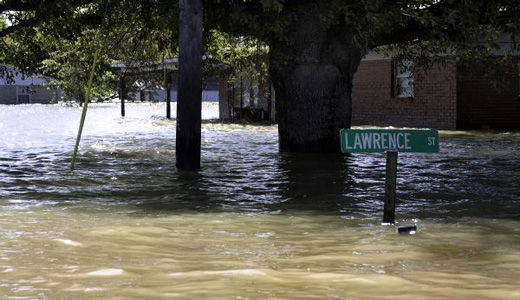
Last month, the U.S. Army Corps of Engineers decided to blow holes in the levee in eastern Missouri’s Birds Point. This month, reported the Kansas City Star, a small African-American town is suffering for it.
The small village of Pinhook, Mo. had about 30 residents. After the blown up levee, the Mississippi River flowed through the town, causing irreparable damage.
The ordeal began when communities near Birds Point were threatened by flooding. In response, the corps blew holes in the levee to relieve pressure. As a result, the floodwaters headed for Pinhook instead. Residents who were fortunate enough to find higher ground did so, with many renting apartments in Sikeston, or moving in with friends in East Prairie. Though some residents hoped to return after the waters receded, said the report, inspections indicated that it probably won’t happen.
According to Heartland News, Pinhook Mayor Debra Tarver said that residents want the government to move them to another location in Mississippi County, but East Prairie state representative Steve Hodges said that’s not likely to come to pass.
“I don’t know where the money would come from,” explained Hodges. “I think it would be a very nice gesture,” he noted, and added that he believed it was “the government’s responsibility, to some extent.”
Hodges said that he did expect FEMA or the corps to reimburse the townsfolk somehow, but admitted that, for the most part, they would be on their own.
In an article in the Kansas City Star, Pinhook resident George Williams said the town is “never going to recover. It won’t. It’s over with.”
Williams, also known as “Mr. George,” moved to Pinhook in 1952, and recalled how difficult it was for an African-American during that time period, noting that he was called “the N-word” to his face on more than one occasion.
“A black person had a hard way to go down there,” he said. But nevertheless, he started a family there, and he noted, “It was a real community. It was a great big family. It really makes me sad. Me and my wife worked hard to build a house for our kids and it’s just where they all grew up.”
But Mr. George was doubtful of the potential for any positive future for Pinhook.
“Even if they move everybody together,” he said, “it still won’t be no Pinhook. It’s just a ghost town down there.”
Anita Nance, a former resident of Pinhook who now resides in New York City, told the Southeast Missourian, “It will always be home to me. It was the most amazing childhood I can ever imagine. I can’t imagine a world where Pinhook doesn’t exist.”
Now, it seems that Pinhook does, in fact, no longer exist.
Steve Hodges said that Pinhook was home to many of his dearest friends, reported the Missourian. He mentioned that he played high school football with them during the 1960s, and recalled a time when the team refused to eat at a restaurant that wouldn’t allow African-Americans inside. Hodges believed that Pinhook was full of good people who carved out their own little section of the world for themselves, and hated to see what was happening to them now.
“It’s a shame,” Hodges remarked. “That was such a great community.” Now, he said, “it’s probably going to be lost in time.”
Photo: The village of Pinhook today. Steve Zumwalt/FEMA










